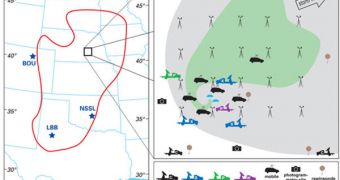Scheduled to begin next week, the most ambitious weather experiment in the world will take place between May 10th and June 13th in the central parts of the United States, all over the Great Plains, on an area of about 900 square miles. It will be conducted by an inter-disciplinary team of researchers from the National Oceanic and Atmospheric Administration (NOAA), the National Center for Atmospheric Research (NCAR), as well as by ten universities and three other groups from America, Canada and Australia.
The Verification of Rotation in Tornadoes EXperiment 2, also known as VORTEX2 or V2, is squarely aimed at studying the formation, evolution, and structure of tornadoes, so that experts dealing with setting up hurricane / tornado defenses could get the best information available. Thus far, a study of such magnitude has never before been attempted. During the study, some 50 scientists will operate 40 vehicles, especially equipped for this kind of research. Ten of these cars are mobile radars, Doppler pulse radars, to be more precise.
This class of radars has the ability to assess a storm's orientation, strength, as well as to determine its possible course over a period of time. It can also tell how strong the drops of rain are falling, and is able to predict shifts in the wind orientation before they happen. This kind of forecast will be essential during the pursuits, when those at the wheel will drive their respective vehicles dangerously close to the massive twisters and tornadoes, in hopes of collecting the most relevant data. Unfortunately, there are currently no better ways of directly assessing such formations, and then getting as close to them as possible.
“An important finding from the original VORTEX experiment was that the factors responsible for causing tornadoes happen on smaller time and space scales than scientists had thought. New advances will allow for a more detailed sampling of a storm's wind, temperature and moisture environment and lead to a better understanding of why tornadoes form – and how they can be more accurately predicted,” Stephan Nelson, who is the National Science Foundation (NSF) program director for Physical and Dynamic Meteorology, said last month.
“We still do not completely understand the processes that lead to tornado formation and shape its development. We hope that VORTEX2 will provide the data we need to learn more about the development of tornadoes and in time help forecasters give people more advance warning before a tornado strikes,” VORTEX2's principal investigator, NCAR's Earth Observing Laboratory Director Roger Wakimoto, added.
“VORTEX2 will help us better understand the difference between thunderstorms that produce tornadoes and those that don't. By identifying the characteristics of severe thunderstorms that produce tornadoes, forecasters will be able to issue tornado warnings further in advance and potentially save lives,” PhysOrg quotes David Dowel, a scientist at NCAR and a VORTEX2 field coordinator, as saying.

 14 DAY TRIAL //
14 DAY TRIAL //